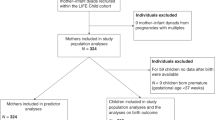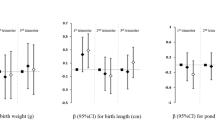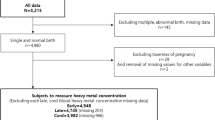Abstract
It has been suggested that prenatal exposure to some organochlorine compounds (OCs) may adversely affect thyroid function and may, therefore, impair neurodevelopment. The main aim of this study was to examine the relationship of cord serum levels of 1,1,1-trichloro-2,2-bis(4-chlorophenyl)ethane (4,4′-DDT), 1,1-dichloro-2,2-bis(4-chlorophenyl)ethylene (4,4′-DDE), β-hexachlorocyclohexane (β-HCH), hexachlorobenzene (HCB), four individual polychlorobiphenyl (PCB) congeners (118, 138, 153, and 180), and their sum, with neonatal thyroid stimulating hormone (TSH) levels in blood samples in a mother–infant cohort in Valencia, Spain. This study included 453 infants born between 2004 and 2006. We measured OC concentrations in umbilical cord serum and TSH in blood of newborns shortly after birth. Associations between neonatal TSH levels and prenatal OC exposure adjusted for covariates were assessed using multivariate linear regression analyses. Neonatal TSH levels tended to be higher in newborns with β-HCH levels in umbilical cord above 90th percentile (104 ng/g lipid) than in those with levels below the median (34 ng/g lipid), with an adjusted increment in neonatal TSH levels of 21% (95% confidence interval=−3, 51; P=0.09). No statistically significant association was found between the remaining OCs and TSH at birth. Prenatal exposure to β-HCH may affect neonatal thyroid hormone status and its function in neurological development.
This is a preview of subscription content, access via your institution
Access options
Subscribe to this journal
Receive 6 print issues and online access
$259.00 per year
only $43.17 per issue
Buy this article
- Purchase on Springer Link
- Instant access to full article PDF
Prices may be subject to local taxes which are calculated during checkout

Similar content being viewed by others
References
Abrams B., Altman S.L., and Pickett K.E. Pregnancy weight gain: still controversial. Am J Clin Nutr 2000: 71 (5 Suppl): 1233S–1241S.
Alvarez-Pedrerol M., Ribas-Fito N., Torrent M., Carrizo D., Garcia-Esteban R., Grimalt J.O., and Sunyer J. Thyroid disruption at birth due to prenatal exposure to beta-hexachlorocyclohexane. Environ Int 2008: 34 (6): 737–740.
Alvarez-Pedrerol M., Ribas-Fito N., Torrent M., Carrizo D., Grimalt J.O., and Sunyer J. Effects of PCBs, p,p'-DDT, p,p'-DDE, HCB and {beta}-HCH on thyroid function in preschoolers. Occup Environ Med 2007a: 65 (7): 452–457.
Alvarez-Pedrerol M., Ribas-Fito N., Torrent M., Julvez J., Ferrer C., and Sunyer J. TSH concentration within the normal range is associated with cognitive function and ADHD symptoms in healthy preschoolers. Clin Endocrinol (Oxf) 2007b: 66 (6): 890–898.
Ataniyazova O.A., Baumann R.A., Liem A.K., Mukhopadhyay U.A., Vogelaar E.F., and Boersma E.R. Levels of certain metals, organochlorine pesticides and dioxins in cord blood, maternal blood, human milk and some commonly used nutrients in the surroundings of the Aral Sea (Karakalpakstan, Republic of Uzbekistan). Acta Paediatr 2001: 90 (7): 801–808.
Barona-Vilar C., Mas-Pons R., and Fullana-Montoro A. Neonatal thyrotropinemia (TSH) as an indicator of iodine nutritional level in Castellon and Valencia, Spain (2004–2006). Rev Esp Salud Publica 2008: 82 (4): 405–413.
Boas M., Feldt-Rasmussen U., Skakkebaek N.E., and Main K.M. Environmental chemicals and thyroid function. Eur J Endocrinol 2006: 154 (5): 599–611.
Breivik K., Pacyna J.M., and Munch J. Use of alpha-, beta- and gamma-hexachlorocyclohexane in Europe, 1970–1996. Sci Total Environ 1999: 239 (1–3): 151–163.
Carrascosa A., Yeste D., Copil A., Almar J., Salcedo S., and Gussinye M. Anthropometric growth patterns of preterm and full-term newborns (24–42 weeks' gestational age) at the Hospital Materno-Infantil Vall d'Hebron (Barcelona) (1997–2002). An Pediatr (Barc) 2004: 60 (5): 406–416.
Carrizo D., Grimalt J.O., Ribas-Fito N., Sunyer J., and Torrent M. Physical-chemical and maternal determinants of the accumulation of organochlorine compounds in four-year-old children. Environ Sci Technol 2006: 40 (5): 1420–1426.
Chevrier J., Eskenazi B., Bradman A., Fenster L., and Barr D.B. Associations between prenatal exposure to polychlorinated biphenyls and neonatal thyroid-stimulating hormone levels in a Mexican-American population, Salinas Valley, California. Environ Health Perspect 2007: 115 (10): 1490–1496.
Chevrier J., Eskenazi B., Holland N., Bradman A., and Barr D.B. Effects of exposure to polychlorinated biphenyls and organochlorine pesticides on thyroid function during pregnancy. Am J Epidemiol 2008: 168 (3): 298–310.
Dallaire R., Dewailly E., Ayotte P., Muckle G., Laliberte C., and Bruneau S. Effects of prenatal exposure to organochlorines on thyroid hormone status in newborns from two remote coastal regions in Quebec, Canada. Environ Res 2008: 108 (3): 387–392.
Dewailly E., Bruneau S., Ayotte P., Laliberte C., Gingras S., Belanger D., and Ferron L. Health status of birth of Inuit newborn prenatally exposed to organochlorines. Chemosphere 1993: 27 (1–3): 359–366.
Domingo-Salvany A., Regidor E., Alonso J., and Alvarez-Dardet C. Proposal for a social class measure. Working Group of the Spanish Society of Epidemiology and the Spanish Society of Family and Community Medicine. Una propuesta de medida de la clase social. Grupo de Trabajo de la Sociedad Espanola de Epidemiologia y de la Sociedad Espanola de Medicina de Familia y Comunitaria. Aten Primaria 2000: 25 (5): 350–363.
Dussault J.H., and Ruel J. Thyroid hormones and brain development. Annu Rev Physiol 1987: 49: 321–334.
Eriksson P., Ahlbom J., and Fredriksson A. Exposure to DDT during a defined period in neonatal life induces permanent changes in brain muscarinic receptors and behaviour in adult mice. Brain Res 1992: 582 (2): 277–281.
Eskenazi B., Marks A.R., Bradman A., Fenster L., Johnson C., Barr D.B., and Jewell N.P. In utero exposure to dichlorodiphenyltrichloroethane (DDT) and dichlorodiphenyldichloroethylene (DDE) and neurodevelopment among young Mexican American children. Pediatrics 2006: 118 (1): 233–241.
Fenster L., Eskenazi B., Anderson M., Bradman A., Hubbard A., and Barr D.B. In utero exposure to DDT and performance on the Brazelton neonatal behavioral assessment scale. Neurotoxicology 2007: 28 (3): 471–477.
Fiolet D.C.M., Cuijpers C.E.J., and Lebret E. Exposure to polychlorinated organic compounds and thyroid hormone plasma levels of human newborns. Organohalog Compd 1997: 34: 459–465.
Halldorsson T.I., Thorsdottir I., Meltzer H.M., Nielsen F., and Olsen S.F. Linking exposure to polychlorinated biphenyls with fatty fish consumption and reduced fetal growth among Danish pregnant women: a cause for concern? Am J Epidemiol 2008: 168 (8): 958–965.
Herrera A., Arino A., Conchello P., Lazaro R., Bayarri S., Perez-Arquillue C., and Garrido M.D., et al. Estimates of mean daily intakes of persistent organochlorine pesticides from Spanish fatty foodstuffs. Bull Environ Contam Toxicol 1996: 56 (2): 173–177.
Jacobson J.L., and Jacobson S.W. Prenatal exposure to polychlorinated biphenyls and attention at school age. J Pediatr 2003: 143 (6): 780–788.
Koopman-Esseboom C., Morse D.C., Weisglas-Kuperus N., Lutkeschipholt I.J., van der Paauw C.G., Tuinstra L.G., and Brouwer A., et al. Effects of dioxins and polychlorinated biphenyls on thyroid hormone status of pregnant women and their infants. Pediatr Res 1994: 36 (4): 468–473.
LaFranchi S. Thyroid function in the preterm infant. Thyroid 1999: 9 (1): 71–78.
Lavado-Autric R., Auso E., Garcia-Velasco J.V., Arufe M.C., Escobar del R.F., Berbel P., and Morreale de E.G. Early maternal hypothyroxinemia alters histogenesis and cerebral cortex cytoarchitecture of the progeny. J Clin Invest 2003: 111 (7): 1073–1082.
Longnecker M.P., Klebanoff M.A., Zhou H., and Brock J.W. Association between maternal serum concentration of the DDT metabolite DDE and preterm and small-for-gestational-age babies at birth. Lancet 2001: 358 (9276): 110–114.
Lopez-Espinosa M.J., Lopez-Navarrete E., Rivas A., Fernandez M.F., Nogueras M., Campoy C., and Olea-Serrano F., et al. Organochlorine pesticide exposure in children living in southern Spain. Environ Res 2008: 106 (1): 1–6.
Lopez-Espinosa M.J., Vizcaino E., Murcia M., Llop S., Espada M., Seco V., and Marco A., et al. Association between thyroid hormone levels and 4,4′-DDE concentrations in pregnant women (Valencia, Spain). Environ Res 2009: 109 (4): 479–485.
Maervoet J., Vermeir G., Covaci A., Nelen V., Baeyens W., Schepens P., and Viaene M.K. Association of thyroid hormone concentrations with levels of organochlorine compounds in cord blood of neonates. Environ Health Perspect 2007: 115 (12): 1780–1786.
Mazhitova Z., Jensen S., Ritzen M., and Zetterstrom R. Chlorinated contaminants, growth and thyroid function in schoolchildren from the Aral Sea region in Kazakhstan. Acta Paediatr 1998: 87 (9): 991–995.
Morton L.M., Cahill J., and Hartge P. Reporting participation in epidemiologic studies: a survey of practice. Am J Epidemiol 2006: 163 (3): 197–203.
Otake T., Yoshinaga J., Enomoto T., Matsuda M., Wakimoto T., Ikegami M., and Suzuki E., et al. Thyroid hormone status of newborns in relation to in utero exposure to PCBs and hydroxylated PCB metabolites. Environ Res 2007: 105 (2): 240–246.
Phillips D.L., Pirkle J.L., Burse V.W., Bernert Jr J.T., Henderson L.O., and Needham L.L. Chlorinated hydrocarbon levels in human serum: effects of fasting and feeding. Arch Environ Contam Toxicol 1989: 18 (4): 495–500.
PNA Convenio Estocolmo y Reglamento 850/2004. Plan Nacional de Aplicación del Convenio de Estocolmo y el Reglamento 850/2004, sobre Contaminantes Orgánicos Persistentes, 2007. Subdirección General de Calidad del Aire y Prevención de Riesgos del Ministerio de Medio Ambiente.
Pop V.J., Brouwers E.P., Vader H.L., Vulsma T., van Baar A.L., and de Vijlder J.J. Maternal hypothyroxinaemia during early pregnancy and subsequent child development: a 3-year follow-up study. Clin Endocrinol (Oxf) 2003: 59 (3): 282–288.
Porterfield S.P. Thyroidal dysfunction and environmental chemicals—potential impact on brain development. Environ Health Perspect 2000: 108 (Suppl 3): 433–438.
Ribas-Fito N., Ramon R., Ballester F., Grimalt J., Marco A., Olea N., and Posada M., et al. Child health and the environment: the INMA Spanish Study. Paediatr Perinat Epidemiol 2006: 20 (5): 403–410.
Ribas-Fito N., Sala M., Cardo E., Mazon C., De Muga M.E., Verdu A., and Marco E., et al. Organochlorine compounds and concentrations of thyroid stimulating hormone in newborns. Occup Environ Med 2003: 60 (4): 301–303.
Ribas-Fito N., Torrent M., Carrizo D., Julvez J., Grimalt J.O., and Sunyer J. Exposure to hexachlorobenzene during pregnancy and children's social behavior at 4 years of age. Environ Health Perspect 2007: 115 (3): 447–450.
Rice D., and Barone S.J. Critical periods of vulnerability for the developing nervous system: evidence from humans and animal models. Environ Health Perspect 2000: 108 (Suppl 3): 511–533.
Rodriguez P., Romero-Aliaga E., Pérez Aliaga S., Quiles A., Ramon R., Rebagliato M., and Esplugues A., et al. Análisis descriptivo de la participación y comparación de las inclusiones y rechazos en la cohorte de embarazo INMA-VALENCIA (abstract). Gac Sanit 2006: 20 (Supp): 47.
Rose S.R., Brown R.S., Foley T., Kaplowitz P.B., Kaye C.I., Sundararajan S., and Varma S.K. Update of newborn screening and therapy for congenital hypothyroidism. Pediatrics 2006: 117 (6): 2290–2303.
Schantz S.L., and Widholm J.J. Effects of PCB exposure on neurobehavioral function in animal models. In: Robertson L.W., and Hansen L.G. (Eds.). PCBs: Recent Advances in Environmental Toxicology and Health Effects. University Press of Kentucky, Lexington, 2001, pp. 221–240.
Soechitram S.D., Athanasiadou M., Hovander L., Bergman A., and Sauer P.J. Fetal exposure to PCBs and their hydroxylated metabolites in a Dutch cohort. Environ Health Perspect 2004: 112 (11): 1208–1212.
Steinmetz R., Young P.C., Caperell-Grant A., Gize E.A., Madhukar B.V., Ben-Jonathan N., and Bigsby R.M. Novel estrogenic action of the pesticide residue beta-hexachlorocyclohexane in human breast cancer cells. Cancer Res 1996: 56 (23): 5403–5409.
Tan J., Loganath A., Chong Y.S., and Obbard J.P. Exposure to persistent organic pollutants in utero and related maternal characteristics on birth outcomes: a multivariate data analysis approach. Chemosphere 2009: 74 (3): 428–433.
Torres-Arreola L., Berkowitz G., Torres-Sanchez L., Lopez-Cervantes M., Cebrian M.E., Uribe M., and Lopez-Carrillo L. Preterm birth in relation to maternal organochlorine serum levels. Ann Epidemiol 2003: 13 (3): 158–162.
United Nations Environment Programme. Stockholm Convention on Persistent Organic Pollutants (POPs). Available: http://www.pops.int2007(accessed 2 April 2007). 2007.
Venners S.A., Korrick S., Xu X., Chen C., Guang W., Huang A., and Altshul L., et al. Preconception serum DDT and pregnancy loss: a prospective study using a biomarker of pregnancy. Am J Epidemiol 2005: 162 (8): 709–716.
Waliszewski S.M., Aguirre A.A., Infanzon R.M., Silva C.S., and Siliceo J. Organochlorine pesticide levels in maternal adipose tissue, maternal blood serum, umbilical blood serum, and milk from inhabitants of Veracruz, Mexico. Arch Environ Contam Toxicol 2001: 40 (3): 432–438.
Walker K., Vallero D.A., and Lewis R.G. Factors influencing the distribution of lindane and other hexachlorocyclohexanes in the environment. Environ Sci Technol 1999: 33 (24): 4373–4378.
Weber G., Mora S., Prina Cerai L.M., Siragusa V., Colombini J., Medaglini S., and Fornara C., et al. Cognitive function and neurophysiological evaluation in early-treated hypothyroid children. Neurol Sci 2000: 21 (5): 307–314.
Willet K.L., Ulrich E.M., and Hites R.A. Differenctial toxicity and environmental fates of hexachlorocyclohexane isomers. Environ Sci Technol 1998: 32 (15): 2197–2207.
Acknowledgements
We are grateful to mothers who participated in the study and to the Obstetrics and Data Processing Departments of La Fe Hospital, Valencia. We also thank Richard Davies for editorial assistance. The study was funded by grants from Spanish Ministry of Health and Ministry of Science and Innovation (INMA G03/176, FIS 03/1615, FIS 04/1112, FIS 04/1509, FIS 06/1213, Programa Juan de la Cierva-FSE) and Conselleria of Sanitat, Generalitat Valenciana (030/2008, 036/2008).
Author information
Authors and Affiliations
Corresponding author
Ethics declarations
Competing interests
The authors declare no conflict of interest.
Rights and permissions
About this article
Cite this article
Lopez-Espinosa, MJ., Vizcaino, E., Murcia, M. et al. Prenatal exposure to organochlorine compounds and neonatal thyroid stimulating hormone levels. J Expo Sci Environ Epidemiol 20, 579–588 (2010). https://doi.org/10.1038/jes.2009.47
Received:
Accepted:
Published:
Issue Date:
DOI: https://doi.org/10.1038/jes.2009.47
Keywords
This article is cited by
-
Prenatal β-Hexachlorocyclohexane (β-HCH) Exposure and 7-Year Child IQ in the CHAMACOS Birth Cohort
Neurotoxicity Research (2020)
-
Protocol of the PSYCHOTSH study: association between neonatal thyroid stimulating hormone concentration and intellectual, psychomotor and psychosocial development at 4–5 year of age: a retrospective cohort study
Archives of Public Health (2014)



